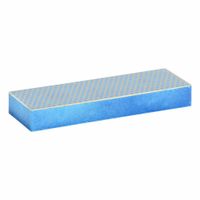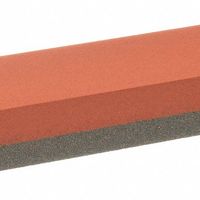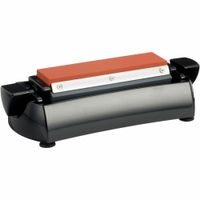Call +(254) 703 030 000 / 751 483 999 / 721 704 777
- Home
- Abrasives
- Sharpening
- Sharpening Stones
.....Read More
Frequently Asked Questions
What is the best sharpening stone for beginners?
The best sharpening stone for beginners is typically a double-sided whetstone with a combination of grit levels, such as 1000/6000. This type of stone offers versatility and ease of use, making it ideal for those new to sharpening.
A 1000-grit side is considered medium-coarse and is perfect for repairing small nicks and reshaping the edge of a dull knife. It provides a good balance between removing material and refining the edge, which is crucial for beginners who are still developing their technique. The 6000-grit side is a fine grit that polishes and hones the edge, giving it a sharp finish. This combination allows beginners to experience both sharpening and honing without needing multiple stones.
When selecting a whetstone, it's important to choose one that is made from high-quality materials, such as aluminum oxide or ceramic, as these provide consistent results and durability. A stone that comes with a non-slip base or holder is also beneficial, as it ensures stability during use, reducing the risk of accidents.
Additionally, a stone that requires soaking in water before use is often recommended for beginners. Water stones are easier to maintain and clean compared to oil stones, and they provide a smoother sharpening experience.
Brands like King, Sharp Pebble, and Whetstone Cutlery offer reliable options for beginners. These stones are generally affordable, widely available, and come with user-friendly instructions or guides, which can be helpful for those just starting out.
Overall, a 1000/6000 grit double-sided whetstone is a practical and effective choice for beginners, providing the necessary tools to learn and master the art of sharpening.
How do you use a dual-grit sharpening stone?
To use a dual-grit sharpening stone, follow these steps:
1. **Preparation**: Soak the stone in water for 5-10 minutes if it's a water stone. For oil stones, apply a light layer of honing oil. This reduces friction and prevents metal particles from clogging the stone.
2. **Coarse Grit Side**: Start with the coarse grit side to reshape the blade edge. Hold the knife at a consistent angle (usually 15-20 degrees) against the stone. Use your dominant hand to hold the knife handle and your other hand to apply pressure on the blade.
3. **Sharpening Motion**: Move the blade across the stone in a sweeping motion, from heel to tip, maintaining the angle. Apply even pressure and cover the entire edge. Repeat this process 5-10 times on one side, then switch to the other side of the blade.
4. **Check the Edge**: After several passes, check the edge for a burr (a slight, raised edge of metal). This indicates the edge is properly sharpened on that side.
5. **Fine Grit Side**: Flip the stone to the fine grit side for honing. This refines and polishes the edge. Repeat the same sharpening motion, maintaining the angle, but with lighter pressure. This step removes the burr and smooths the edge.
6. **Final Touches**: Alternate sides with each stroke to ensure a balanced edge. Continue until the blade is sharp to your satisfaction.
7. **Cleaning**: Rinse the stone to remove metal filings and debris. Dry it thoroughly to prevent damage.
8. **Testing**: Test the sharpness by slicing through paper or gently shaving hair on your arm. A sharp blade should cut smoothly without tearing.
9. **Storage**: Store the stone in a dry place to prevent damage.
What is the difference between diamond and traditional sharpening stones?
Diamond sharpening stones and traditional sharpening stones differ primarily in their materials, durability, and sharpening efficiency.
Diamond sharpening stones are made by bonding diamond particles to a metal or resin base. Diamonds, being the hardest known material, provide a very efficient and fast sharpening process. These stones are particularly effective for sharpening hard metals and can quickly restore a blade's edge. They are also durable and maintain their flatness over time, which is crucial for consistent sharpening results. Diamond stones can be used dry or with water, making them convenient and low-maintenance.
Traditional sharpening stones, also known as whetstones, can be made from natural or synthetic materials such as novaculite, aluminum oxide, or silicon carbide. They come in various grit levels, allowing for both coarse sharpening and fine honing. Traditional stones often require lubrication with water or oil to prevent clogging and to ensure smooth sharpening. They may wear down over time, requiring flattening to maintain an even surface. While they may not be as fast as diamond stones, they offer a wide range of grit options for precise edge refinement.
In summary, diamond stones are known for their speed, durability, and ability to handle hard materials, while traditional stones offer versatility in grit selection and are often preferred for achieving a polished edge. The choice between the two depends on the user's specific sharpening needs, preferences, and the types of tools being sharpened.
How often should you sharpen your knives with a sharpening stone?
The frequency with which you should sharpen your knives using a sharpening stone depends on several factors, including the type of knife, its usage, and the material of the blade. Generally, for home cooks, sharpening with a stone is recommended every 2-4 months. However, this can vary:
1. **Usage Frequency**: If you use your knives daily, you may need to sharpen them more often, perhaps every 1-2 months. For less frequent use, every 4-6 months might suffice.
2. **Blade Material**: High-carbon steel knives tend to dull faster than stainless steel and may require more frequent sharpening. Conversely, harder steel blades retain their edge longer but can be more challenging to sharpen.
3. **Knife Type**: Different knives have different sharpening needs. For instance, a chef's knife used for various tasks will need more frequent sharpening than a paring knife used occasionally.
4. **Cutting Surface**: Using a cutting board made of softer materials like wood or plastic can help maintain the edge longer compared to harder surfaces like glass or stone.
5. **Maintenance**: Regular honing with a honing rod can extend the time between sharpenings by realigning the edge of the blade.
6. **Signs of Dullness**: If you notice your knife struggling to cut through food, slipping off surfaces, or requiring more force, it’s time to sharpen.
Ultimately, the best approach is to monitor your knives' performance and sharpen them as needed. Regular maintenance and proper storage can also help prolong the sharpness of your knives.
What grit sharpening stone should I use for my kitchen knives?
For kitchen knives, the choice of sharpening stone grit depends on the condition of the blade and the desired sharpness. Here’s a guide:
1. **Coarse Grit (200-600):** Use a coarse grit stone if your knife is very dull or has nicks and chips. This grit level is effective for reshaping the edge and removing significant material quickly. However, it leaves a rough edge that requires further refinement.
2. **Medium Grit (800-2000):** A medium grit stone is suitable for regular sharpening and maintaining a reasonably sharp edge. If your knife is moderately dull but not damaged, start with this grit. It balances material removal and edge refinement, making it ideal for routine maintenance.
3. **Fine Grit (3000-6000):** Fine grit stones are used for honing and polishing the edge to achieve a razor-sharp finish. After using a medium grit stone, progress to a fine grit to refine the edge further. This grit level is perfect for achieving a smooth, sharp edge suitable for precision cutting tasks.
4. **Extra Fine Grit (8000+):** For those seeking an ultra-sharp, mirror-like finish, an extra fine grit stone is the final step. It’s typically used by professional chefs or enthusiasts who require the highest level of sharpness for delicate tasks.
**General Recommendation:** For most home cooks, a combination stone with medium and fine grits (e.g., 1000/3000 or 1000/6000) is sufficient. This allows for regular maintenance and achieving a sharp edge without the need for multiple stones. If your knives are heavily used or damaged, consider adding a coarse grit stone to your collection.
Remember, proper technique and consistent angle maintenance are crucial for effective sharpening, regardless of the grit used.
How do you maintain and clean a sharpening stone?
To maintain and clean a sharpening stone, follow these steps:
1. **Preparation**: Before cleaning, ensure the stone is dry. If it's a water stone, let it dry completely. For oil stones, wipe off excess oil with a paper towel.
2. **Cleaning**: Use a stiff brush or nylon scrubbing pad to remove metal filings and debris. For water stones, use water and a mild detergent. For oil stones, use mineral oil or honing oil to loosen grime.
3. **Flattening**: Over time, sharpening stones can become uneven. Use a flattening stone or a piece of wet/dry sandpaper on a flat surface. Rub the sharpening stone in a circular motion until it's flat.
4. **Rinsing**: Rinse the stone thoroughly with water to remove any remaining particles. For oil stones, wipe with a clean cloth soaked in mineral oil.
5. **Drying**: Allow the stone to air dry completely. Avoid direct sunlight or heat sources, which can cause cracking.
6. **Storage**: Store the stone in a dry, cool place. For water stones, ensure they are completely dry before storing to prevent mold. For oil stones, a light coating of mineral oil can prevent rust.
7. **Regular Maintenance**: After each use, clean the stone to prevent buildup. Regular flattening ensures even sharpening surfaces.
By following these steps, you can maintain the effectiveness and longevity of your sharpening stone.
Can you use water instead of oil on a sharpening stone?
Yes, you can use water instead of oil on a sharpening stone, but it depends on the type of stone. Water stones, also known as whetstones, are specifically designed to be used with water. They are made from softer materials that wear down with use, exposing fresh abrasive surfaces. Using water helps to create a slurry that aids in sharpening and prevents metal particles from clogging the stone.
Oil stones, on the other hand, are traditionally used with oil. They are typically made from materials like aluminum oxide or novaculite. Oil acts as a lubricant and helps to float away metal filings, preventing the stone from becoming clogged. However, once a stone has been used with oil, it is difficult to switch to water because oil residues can repel water, making it less effective.
If you have a dual-purpose stone, you can choose to use either water or oil, but it’s important to stick with one once you’ve started. Switching between the two can lead to reduced effectiveness. Water is often preferred for its ease of cleanup and environmental friendliness, while oil can provide a smoother sharpening experience.
In summary, whether you can use water instead of oil depends on the type of sharpening stone you have. Water stones are designed for use with water, while oil stones are meant for oil. Dual-purpose stones offer flexibility, but consistency in the choice of lubricant is key for optimal performance.





